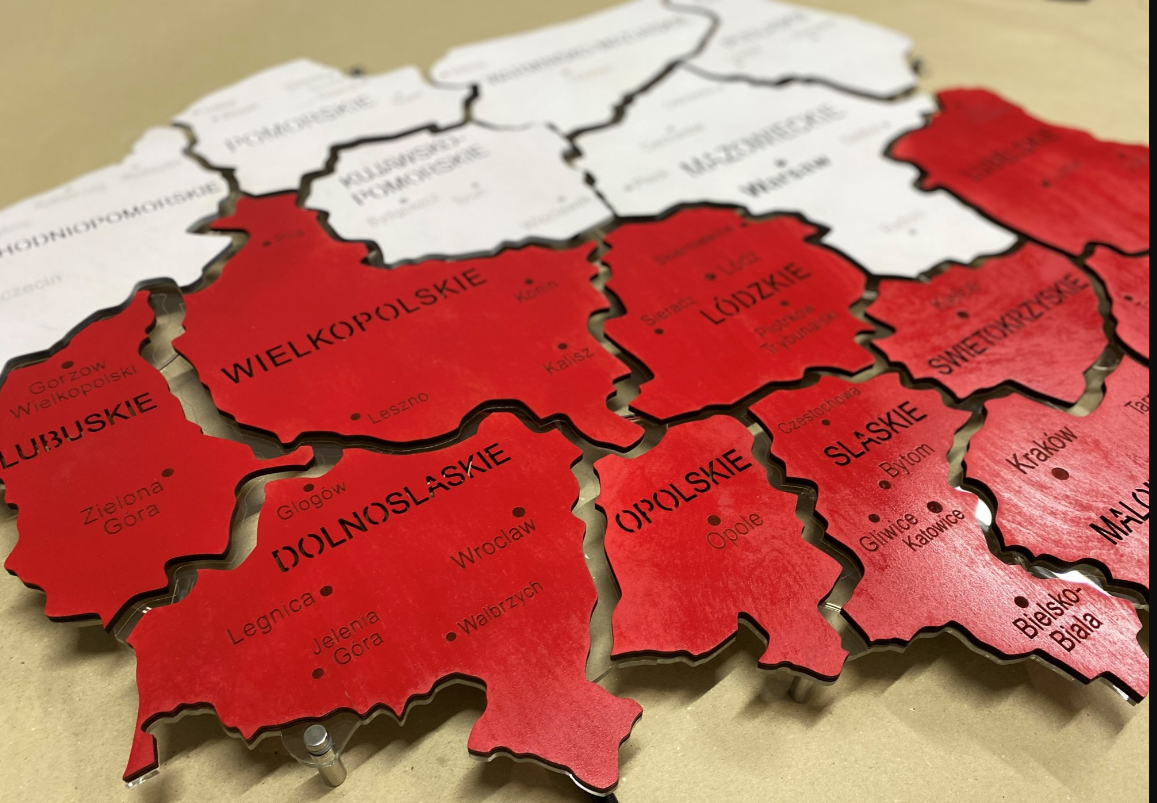Administrative divisions of Poland: Voivodeships, Povets and Gminas
-
Yuri Seleznev
Copywriter Elbuz
Do you know that society is a complex structure, like a puzzle, where every piece has its place? But what if I told you that in Poland this puzzle looks completely different? Are you interested in knowing how exactly this mosaic of administrative divisions of Poland is formed? The answer lies in the Voivodships, Powiats and Gminas. Yes, I know, these terms seem unusual and mysterious to you, but today I will sort out all these complexities and tell you how voivodships, powiats and communes function in modern Polish society. Are you ready to go on an exciting journey through Polish regions and discover their uniqueness? Then let's get started...

Glossary
Voivodeship: An administrative unit in Poland corresponding to a region or region. The administration of the voivodeship is carried out by the voivode, who is appointed by the president. Voivodeships exercise control and regulation of activities on their territory in accordance with legislative and legal norms.
Powiat: A subdivision within a voivodeship, similar to a district or district in other countries. Powiats are governed by a headman, who is elected by residents in local elections. Their responsibilities include managing territorial development, providing local services and solving problems related to the development of the region.
Gmina: The smallest administrative unit in Poland. Gminas can be rural or urban. They have their own self-government, which is elected in local elections. The tasks of the gmina include managing the local budget, providing public services, solving local problems and planning territorial development.
City with the rights of a powiat: A city that has the status of a powiat, i.e. areas of self-government, regardless of belonging to a particular poviat or commune. These cities have their own government and perform the functions of a poviat.
Addresses and locations of administrative units: Information on the location and addresses of voivodeships, powiats and communes. Such information makes it possible to identify specific administrative units and determine their geographical location.
Administrative structure of Poland
The administrative division of Poland has a three-level structure, which includes voivodeships (województwo), powiats or districts (powiat) and gminas (gmina). Each of these levels plays a specific role in the organization and management of the country.
Voivodeships
Voivodeships are the largest administrative units in Poland and divide the country into 16 regions. This system has existed since 1999, but previously the administrative division had other forms. For example, from 1946 to 1950 there were 14 voivodeships, and from 1950 to 1975 their number increased to 17. From 1975 to 1998, the country was divided into 49 voivodeships. After the reform of 1999, the number of voivodeships became 16.
Voivodeships have their own capitals, where the authorities are located. Some voivodeships have common capitals if the authorities are located in different cities. It is important to note that former voivodeship capitals, which lost their status after the 1999 reform, are exceptions to this system.

Voivodeships have their own unique characteristics and implement policies in the region. They are engaged in economic development, creating conditions for investment, relations with other regions and educational policy. The voivodeship level makes it possible to resolve important issues that cannot be resolved at the local level.
Powiats
Powiat or povet is the next administrative unit of Poland. Voivodships are divided into powiats, and each powiat is in turn divided into gminas. There are currently 379 powiats in Poland, of which 314 are rural and 66 are urban.
Poviats perform functions that cannot be solved at the commune level. Their competence includes issues such as ensuring public order and safety, protecting the environment and nature, maintaining local communal facilities and administrative premises, resolving issues of agriculture, forestry and inland fisheries, protecting consumer rights and others.
Communes
The commune is the lowest administrative unit in Poland. This term is similar to the Russian word "community" or the German "gemeinde". The commune resolves issues of local importance that are not within the competence of other administrative units. There are a large number of communes in Poland, both rural and urban.
Communes perform many functions, including health care, social assistance, property management, organizing public transport, supporting education and culture, ensuring security and public order. They also deal with issues of public utilities, environmental protection and other areas.
Summary
The administrative structure of Poland is a three-tier system, including voivodeships, powiats and communes. Each of these levels performs its own functions and plays its role in the organization and management of the country. Voivodeships determine the policy of the region, poviats resolve issues that cannot be resolved at the commune level, and communes deal with issues of local importance. All these administrative units work together to ensure the development and well-being of Poland.

Poland is a unique country with interesting features in its administrative structure. Understanding this system will help you better interact with local authorities and know your rights and options. Peek into the depths of Poland's administrative structure and plunge into the world of government and self-government.
🌍 Addresses and locations of administrative units in Poland
Poland is an amazing country with a rich history and a complex structure of government management. In modern Poland there are three levels of administrative division, including voivodships, powiats and communes. In this section we will look at them in more detail and explain how they are organized.

Voivodeships - administrative areas of the country
The highest level of administrative division in Poland is voivodeships . In total, there are 16 voivodeships in the country, each of which has its own voivode, who serves as the head of the region.
Voivodeships are administrative areas with their own borders and administrative centers. They play an important role in organizing and managing government and social issues in their territory. Voivodeships perform a variety of functions, including the development of regional development strategies, control of economic processes, provision of public services, etc.
Interestingly, each of the voivodeships has its own uniqueness and characteristics. For example, the Warmian-Masurian Voivodeship is known for its numerous lakes and beautiful natural landscapes, while the Lesser Poland Voivodeship attracts tourists with its wonderful cities such as Krakow and Zakopane.
Powiats - district administrations within voivodeships
At the next level of administrative division are poviats. A powiat or district is an administrative-territorial unit that is part of a voivodeship. In total, there are about 300 powiats in Poland, and each of them has its own district administration, responsible for conducting socio-economic and administrative activities on its territory.
Poviats play an important role in the lives of citizens, providing a wide range of services to the population. They are engaged in organizing support for local entrepreneurs, developing education, healthcare, culture and public order. In addition, powiats are responsible for maintaining a unified population register, managing land resources and coordinating local activities.

Communes - settlements and their self-government
A commune is a settlement that can be a village, city or community. There are more than 2,500 communes in Poland, each of which has its own self-government and local government.
Communes deal with various socio-economic and cultural issues at the local level. They control population structure, land use, social security, local infrastructure development and other important aspects of community life.
When choosing a commune that provides a specific service, you can go to the official website gminy.pl. This portal provides information about the addresses of authorities and local governments. This is a useful resource for foreigners and residents of the country, allowing you to quickly and easily obtain the necessary information.
gminy.pl projects and their availability
The gminy.pl website provides a wide range of services and information about gminas in Poland. On its platform you can find the addresses of authorities, their contact details and the schedule of reception of citizens. It is important to note that some functions of the portal are paid, but at the time of publication of a number of articles this service was provided free of charge.
If you want to use the gminy.pl portal, follow simple instructions:
- Visit the official website gminy.pl
- At the top of the page, select the voivodeship that interests you.
- On the next page you will see a map of the selected voivodeship indicating the powiats that are part of it.
- Select the county you need and review the available information.
Please remember that the information on the gminy.pl website may not be current or may change over time. If you find any inconsistencies, we recommend reporting it in the comments to the article or directly on the gminy.pl website.
🔍 Useful information about communes and their addresses
| What's useful | What not to do |
|---|---|
| Use portal gminy.pl to obtain addresses of communes and authorities | Transfer of personal information on unreliable sites |
| Visiting official sites communes to obtain up-to-date information | Using illegal resources to obtain contacts of authorities |
| Commenting on articles and reliable sources for reporting about changes in addresses and contact information | Using outdated or unreliable sources of information |
| Complying with current safety regulations when interacting with information on the portal | Dissemination of false information not confirmed by reliable sources |
So, now you know what voivodeships, powiats and communes are in Poland, as well as the organization of their administrative divisions. Find the commune or authority you are interested in on the portal gminy.pl and get the up-to-date information you need.
We hope that the information provided will help you understand the structure of government in Poland and allow you to effectively interact with relevant authorities and organizations.

📌 Hint: If you If you have questions or require additional information about communes, voivodeships or powiats, please contact official sources or consultants familiar with this topic.
Voivodeships, powiats and communes: administrative divisions of Poland
When we talk about the state, We rarely think about its internal administrative structure. However, in order to fully understand the country, it is important for us to understand its administrative divisions. So what are voivodeships, powiats and communes, and how are they organized in Poland?
Voivodeships: regions with special status
Voivodeships, or voivodeships, are the highest level of administrative division in Poland. The country is divided into 16 voivodeships, each of which has its own center and its own government. Voivode, the regional head, heads the voivodeship and exercises executive power.
Voivodeships in Poland have a special status because they focus on solving many important issues of regional importance. These include social security, environmental protection, infrastructural development, tourism, healthcare and much more. Voivodeships play an important role in coordinating and implementing government policies at the regional level.
Poviats: links in the administrative hierarchy
At the second level of the administrative hierarchy are poviats. A powiat is a county that is an intermediate link between a voivodeship and a gmina. Each voivodeship consists of various powiats - in total there are more than 300 in all of Poland.
The main function of powiats is to ensure the efficient operation of administrative-territorial units. They are responsible for local government processes, exercise control over communes, and develop and implement local policies and programs. It is important to note that powiats also have their own bodies of self-government, including the sejmik and the marshal of the poviat.
Communes: basic administrative units
Communes are the smallest administrative units in Poland. They constitute the third level of administrative division and operate at the territorial level. Each powiat consists of several gminas.
In Poland there are two types of gminas: urban and rural. City communes are part of larger cities, including Warsaw, Krakow and Gdańsk. Rural communes, on the other hand, include small settlements, rural areas and villages.
Communes are responsible for solving local issues and ensuring local social, economic and cultural development. They are involved in the local budget, education, healthcare, infrastructure development and the organization of social services.

Conclusion
The administrative division of Poland is based on three levels: voivodeships, powiats and communes. This system is the basis for the effective organization and management of various aspects of life in the country. Voivodeships, as the highest level, coordinate regional issues, poviats are involved in intermediate management, and communes are the basic units that resolve local issues.
Understanding the administrative divisions of Poland is important for anyone interested in this amazing country. Now you have a complete understanding of voivodeships, powiats and communes, their roles and functions. Be sure that you will always know where to turn if you need help or advice on various issues while staying in Poland.
"Understanding the administrative divisions in Poland is the key to successfully interacting with authorities at all levels and resolving various issues in the country." - Anna Zbyszek, expert in Polish administrative law.
Table: Overview of useful knowledge about voivodeships, counties and communes
| Administrative division level | Main tasks and functions |
|---|---|
| Voivodeships | - Regional management and coordination; - Environmental protection and social security; - Infrastructural development. |
| Powiats | - Local management and control; - Development and implementation of local policies and programs; - Self-government bodies. |
| Communes | - Solving local issues and ensuring local development; - Local budget management and organization of social services; - Infrastructure development and education. |
Understanding the structure of administrative divisions in Poland will make it much easier to navigate its internal structure. Knowing the roles and functions of voivodeships, powiats and communes will help you obtain the necessary services and support locally. The separation of powers and levels of government in Poland contributes to the efficient functioning of the state and improves the quality of life of its citizens.

Frequently asked questions on the topic "Detailed explanation of Voivodeships, Powiats and Gminas in Poland"
- 1. What are voivodeships in Poland?
- Voivodeships in Poland are the largest administrative division level. They are regions and have independent legislation and governance.
- 2. What are powiats in Poland and how are they related to voivodships?
- Powiats are districts that are part of voivodeships. They carry out more detailed administrative control within the respective voivodeship.
- 3. What functions do powiats perform in Poland?
- Poviats are responsible for local government, including education, health care, transport infrastructure, and regulation of construction and land use.
- 4. What are gminas in Poland and how do they relate to powiats?
- Communes are the smallest administrative units within powiats. They include urban and rural communes, which have their own governing bodies.
- 5. What tasks do communes perform in Poland?
- Communes are responsible for issues related to local infrastructure, public services, culture, environmental protection and local budgets.
- 6. How are voivodeships governed in Poland?
- Voivodeships are governed by voivodes, who are representatives of the central government and appointed by the President. They exercise control over the implementation of legislation and regulate voivodeship issues.
- 7. How are powiats governed in Poland?
- The poviat is governed by the Poviat Sejmik, which is elected by the population of the poviat. The Poviat Sejmik makes decisions on issues related to the poviat level.
- 8. What is a “city with the rights of a powiat” in Poland?
- "A city with the rights of a powiat" is a city that has the status of a poviat. Such a city has its own governing bodies and carries out poviat functions.
- 9. How are communes governed in Poland?
- Communes are governed by the commune assembly and the head of the commune, who are elected by the population of the commune. They make decisions on local issues and manage the work of the commune.
- 10. Where can I find addresses and locations of administrative units in Poland?
- Addresses and locations of administrative units in Poland can be found on the official websites of the respective voivodeships, powiats and communes, as well as in the state register of administrative units.
Thank you for teaching!
🎉 Congratulations! 🎉 You have just become an expert on voivodships, powiats and communes in Poland! Now you have knowledge that will help you better understand and appreciate the organization of the administrative divisions of this amazing country. We hope that our explanations were useful and interesting for you.
Now you know that voivodeships are the highest level of administrative division in Poland, and they are divided into many powiats. Each powiat, in turn, consists of gminas. This three-tier system plays an important role in the organization and management of the country, ensuring more efficient governance and closer communication with citizens.
We hope that now you have a better understanding of how the administrative divisions of Poland are structured and how they serve as the basis for the organization of state power. You have knowledge that was previously only available to professionals in the field. Now, thanks to this article, you understand all the intricacies!
Don't forget to share your new expert knowledge with your friends and colleagues. Who knows, maybe they will be interested in learning more about the administrative divisions of Poland and you will get additional pleasure from discussing this topic.
Thank you for reading this article and thank you for your attention! We hope that we have met your expectations and helped you expand your knowledge. Good luck in exploring the wonderful world of voivodeships, powiats and communes in Poland! 💪🌍💙

- Glossary
- Administrative structure of Poland
- Addresses and locations of administrative units in Poland
- Voivodeships, powiats and communes: administrative divisions of Poland
- Frequently asked questions on the topic "Detailed explanation of Voivodeships, Powiats and Gminas in Poland"
- Thank you for teaching!
Article Target
Explain the administrative divisions of Poland and the role of voivodeships, powiats and communes
Target audience
People interested in Poland, travelers, students and researchers carrying out activities related to Poland
Hashtags
Save a link to this article
Yuri Seleznev
Copywriter ElbuzI unravel the secrets of successful online store automation, plunging into the world of effective solutions and secrets of online business - welcome to my virtual labyrinth, where every line is the key to automated success!
Discussion of the topic – Administrative divisions of Poland: Voivodeships, Povets and Gminas
Find out what voivodeships, powiats and communes are in Poland, and how they are organized within the administrative divisions of the country. A detailed explanation of all three levels of administrative division and their role in modern Polish society.
Latest comments
8 comments
Write a comment
Your email address will not be published. Required fields are checked *














.png)

.png)








John
Oh, it’s very interesting to learn more about voivodeships, powiats and communes in Poland! Your article intrigued me. I've heard that Poland has a complex administrative division, but it's always interesting to know more details.
Maria
Poland has a very interesting system of administrative divisions, and voivodeships, powiats and communes play an important role in this system. The levels of administrative division reflect the rural, urban and regional structure of the country. I've always wanted to understand more deeply how they work in practice.
Pierre
Gorgeous! As a Frenchman, I am always inspired by the different governance systems of other countries. I am curious about the influence of voivodships, powiats and communes on politics and society in Poland. This detailed explanation will be very helpful in understanding this system.
Luisa
I also heard a lot about Poland, but never fully understood what their administrative status was. I like that you offer a detailed explanation of the levels of administrative division. I'm looking forward to learning more!
Anna
Poland has always attracted me with its culture and history. But I didn’t know that they had such a complex administrative division system. I am interested to know how this division influenced the development of the regions and what their characteristics are.
GrumpyGeoff
Here's another pointless topic. Why do you need these voivodeships, powiats and communes? What do they really give people? Nothing. Just bureaucratic smoothing out. Don't you have anything better to discuss?
Marta
Oh, here comes Geoff! He is always ready to criticize and finds no interest in anything new. Voivodeships, powiats and communes have their own significance in the organization of the country and regional development. I'm looking forward to a detailed explanation to enrich my knowledge!
Jakub
Why are voivodeships, powiats and communes needed? It is an important part of local government and gives people a voice and influence in their areas. I am interested in learning more about the specific functions of each level of administrative division. Looking forward to your article!